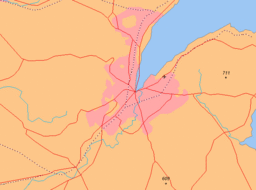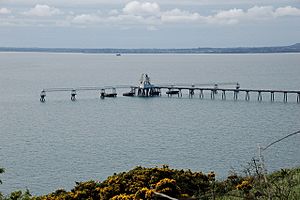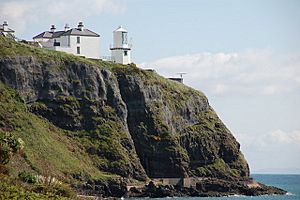Belfast Lough facts for kids
Quick facts for kids Belfast LoughLoch Lao (Irish) Bilfawst Loch (Ulster-Scots) |
|
|---|---|
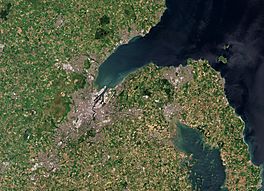
Satellite photo
|
|
| Location | Northern Ireland |
| Coordinates | 54°41′28″N 5°47′06″W / 54.691°N 5.785°W |
| Designated: | 5 August 1998 |
| Reference #: | 958 |
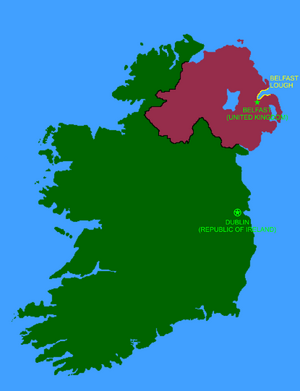
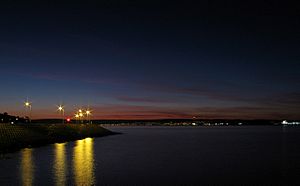
Belfast Lough is a big sea inlet on the eastern coast of Northern Ireland. It's like a long arm of the sea reaching inland. At the very end of this inlet is the city and busy port of Belfast. The River Lagan flows into the lough right there.
The lough connects Belfast to the Irish Sea through the North Channel. It is a long, wide, and deep area of water. The tides here are not very strong.
The inner part of Belfast Lough has many mudflats and lagoons. These are shallow areas where water collects. The outer part of the lough has mostly rocky shores. You can also find some small sandy bays there. The main towns along the coast are Bangor on the south side and Carrickfergus on the north side. Other towns include Holywood and Whitehead.
Contents
What's in a Name?
Belfast Lough has an interesting history behind its name. In the Irish language, it is called Loch Lao. This name means "sea inlet of the calf." The River Lagan, which flows into the lough, was also known as the Lao a long time ago.
People believe that both the lough and the river were named after a "bovine goddess." This is a goddess linked to cows. In the 2nd century, a Greek geographer named Ptolemy called it the Logia.
Before Belfast became a big city, the lough was known in English as 'Carrickfergus Bay'. In Ulster-Scots, it is called Bilfawst Loch or Craigfergus Loch.
A Look at History
Belfast Lough has played a role in history. In 1689, during the War of the Two Kings, a military force led by Marshal Schomberg landed at Bangor. This happened after the lough was cleared of French ships. Schomberg's forces then took over Bangor and Belfast. They also successfully attacked Carrickfergus.
The next year, William III also used the lough as a safe place for his ships. He arrived in Ireland with more soldiers. This was just before his army won the Battle of the Boyne.
Amazing Wildlife
Belfast Lough is home to many different animals. It is a very important place for nature.
Nature Reserve and Special Areas
Part of the lough is a nature reserve. It is managed by the RSPB. They look after mudflats, grasslands, and lagoons. These areas are vital feeding spots for many wading birds and wildfowl.
When the tide is high, you can see large groups of wading birds. These include redshanks, oystercatchers, and black-tailed godwits. The "inner lough" was named an Area of Special Scientific Interest (ASSI) in 1987. This means it is a protected area because of its special wildlife.
Ramsar Site: Wetlands of Importance
Belfast Lough is also a Ramsar site. This means it is a wetland that is important around the world. It was given this special status on August 5, 1998. The site covers a large area of mudflats and lagoons. These are important places for birds to feed and rest in winter.
The lough is especially important for common redshanks in winter. It also supports many other birds. These include common shelducks, Eurasian oystercatchers, purple sandpipers, dunlins, black-tailed godwits, bar-tailed godwits, Eurasian curlews, and ruddy turnstones.
Sailing and Ships
Belfast Lough is a very popular place for sailing. There are three marinas where boats can dock. One is at Bangor, another at Carrickfergus, and a third in the Titanic Quarter of Belfast.
At the head of the lough are the Belfast docks. This is where the famous shipbuilder Harland & Wolff used to build ships. They built the RMS Titanic. Today, they mostly repair and refit large ships and oil rigs.
The Coastguard offices for the lough are in Bangor. They are called Belfast Coastguard. In 1912, the RMS Titanic sailed down the lough from Belfast for its sea trials. This was a test run before its first voyage.
The lough is home to two Royal Yacht Clubs. These are special sailing clubs. Many other sailing clubs are also located around the lough. For racing sailors, the lough offers a huge area of open water. This makes it perfect for both short and long races.
Railway Lines Along the Lough
Two railway lines run along the shores of Belfast Lough.
North Shore Railway
The Belfast-Larne railway line follows the northern shore. It passes through towns like Carrickfergus and Whitehead. Trains on this line connect Belfast Great Victoria Street and Belfast Central to Larne Harbour.
South Shore Railway
The Belfast-Bangor railway line runs along the southern shore. It goes through places like Holywood railway station and Cultra railway station. Trains on this line connect Belfast Great Victoria Street and Belfast Central to Bangor.
Cultra railway station is also where you can find the Ulster Folk and Transport Museum.
See also
 In Spanish: Belfast Lough para niños
In Spanish: Belfast Lough para niños


